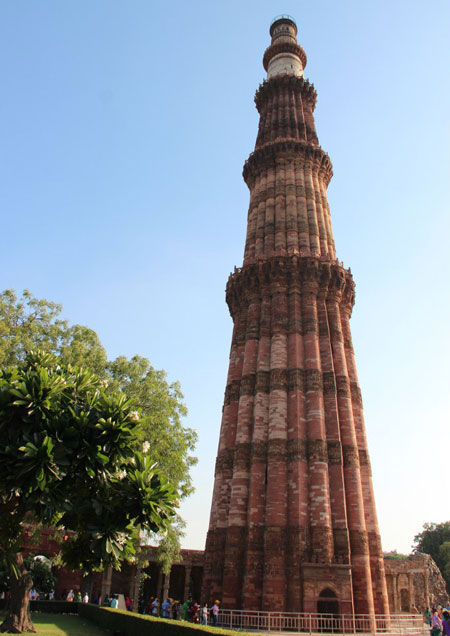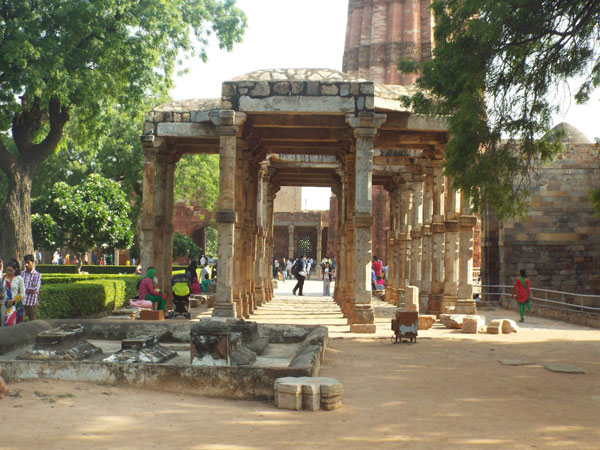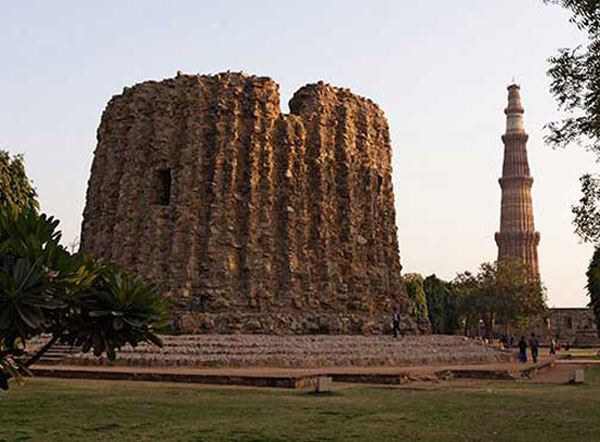Qutub Minar is a minaret that forms part of the Qutb complex, a UNESCO World Heritage Site in the Mehrauli area of Delhi, India.Made of red sandstone and marble, Qutub Minar is a 73-metre (240 feet) tall tapering tower of five storeys, with a 14.3 metre (47 feet) base diameter, reducing to 2.7 metres (9 feet) at the peak. It contains a spiral staircase of 379 steps. Its design is thought to have been based on the Minaret of Jam, in western Afghanistan.
Qutb Ud-Din-Aibak, founder of the Delhi Sultanate, started construction of the Qutub Minar's first storey around 1192. In 1220, Aibak's successor and son-in-law Iltutmish completed a further three storeys. In 1369, a lightning strike destroyed the top storey. Firoz Shah Tughlaq replaced the damaged storey, and added one more.
The Minar is surrounded by several historically significant monuments of the Qutb complex, including Quwwat-ul-Islam Mosque, which was built at the same time as the Minar, and the much older Iron Pillar of Delhi. The nearby pillared Cupola known as "Smith's Folly" is a remnant of the tower's 19th century restoration, which included an ill-advised attempt to add a sixth storey.
History
Kuttull Minor, Delhi. The Qutb Minar, 1805
Qutab Minar in Mehrauli in Delhi. Clifton and Co., around 1890
Qutb Minar was established along with Quwwat-ul-Islam Mosque around 1192, by Qutb-ud-din Aibak, first ruler of the Delhi Sultanate.The mosque complex is one of the earliest that survives in the Indian subcontinent. The minaret is named after Qutb-ud-din Aibak, or Qutbuddin Bakhtiar Kaki, a Sufi saint.[9] Its ground storey was built over the ruins of the Lal Kot, the citadel of Dhillika.[10] Aibak's successor Iltutmish added three more storeys.[9] the fifth layer was built by RAZZIYA SULTAN the first female sulta of INDIA. The minar's topmost storey was damaged by lightning in 1369 and was rebuilt by Firoz Shah Tughlaq, who added another storey. In 1505, an earthquake damaged Qutb Minar; it was repaired by Sikander Lodi. On 1 September 1803, a major earthquake caused serious damage. Major Robert Smith of the British Indian Army renovated the tower in 1828 and installed a pillared cupola over the fifth story, thus creating a sixth. The cupola was taken down in 1848, under instructions from The Viscount Hardinge, then Governor General of India. It was reinstalled at ground level to the east of Qutab Minar, where it remains. It is known as "Smith's Folly".
An inscription in Persian at the mosque's inner eastern gateway states that material used in its construction was salvaged from the demolition of twenty-seven of Delhi's Hindu and Jain temples. Pillars from these demolished temples were used in the mosque, with their iconography intact. The nearby Iron Pillar from the Gupta empire, which predates the Islamic minar and still bears its Brahmic inscriptions, survived as part of the Qutb complex.












